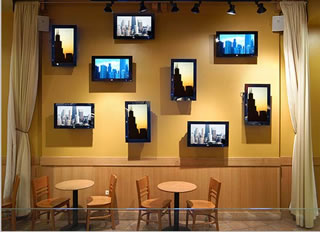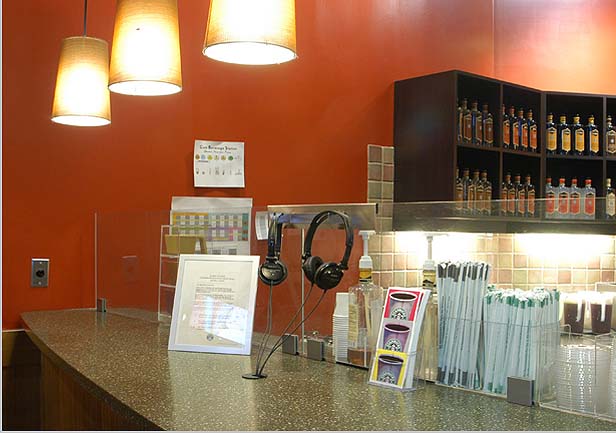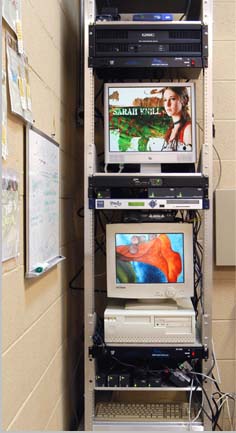by Wendy Ellis, Pro AV Magazine Print | E-mail
AV components become the missing link for multi-screen
entertainment at a Chicago Starbucks.

Most fireflies glow in the dark. This one pings.
At 2 AM every morning, the Focus Enhancements Firefly Media player at the Starbucks Coffee store located at the intersection of Rush and Oak in Chicago reaches out through the dark to a Hewlett Packard server. It’s looking for any changes that may have been made to a trio of video presentations playing daily to audiences on a nine screen video wall at the Chicago coffee shop. This new video wall concept may soon branch out to other Starbucks flagship stores across the country, but for now, Chicago is its proving ground.
That nightly request from the Firefly MC media player became part of the presentation process only after AV systems integration firm Media Resources Inc., of Lisle, Illinois, joined the team attempting to link the artistic and technical elements of the project. “They had the production and the display, but they had no idea how to make the show play,” says Brian Maksa, vice president of sales and rentals for MRI. “Basically, we became the missing link.”
The idea behind the wall came from Starbucks’ desire to provide its employees a venue for displaying their artistic talents. Many of the company’s employees are also musicians, painters, photographers, sculptors, and even film makers. The new “Partner Projection Wall” is their window to the world.
Audio Visual – thinking outside the box
To give the display an artistic flair, the video wall consists of nine 26-inch, HD-ready LCD monitors, five hung horizontally, four vertically. “It looks like paintings on a wall,” says Alex LeMay of Taproot Productions in Chicago, which was tasked with creating digital vignettes of the artists and their work to display in a synchronized loop. “It’s not the nine panel square, three up, three down, you see everywhere. That square box has been done to death.”
While a head and shoulder shot of the artist may be playing on three monitors, two others may show him creating the artwork, while the others display the work itself. Each vignette runs about 5 minutes, before the video returns to “attract mode,” which highlights scenes of Chicago until the next vignette begins, or until someone pushes a button located nearby on the wall to start the next show.
It was the smooth synchronization of this montage of videos that had programmers stumped. “When we were finally brought in, the monitors were up and they had pulled the Cat5,” Maksa says. “But they were having difficulty synchronizing the videos. They were trying multiple video cards and would have had to write a very complex computer program. Basically, they were going at it from a computer mentality, rather than an AV and control idea. We knew what they needed right away, because from an AV standpoint it hits you right in the face.”
MRI began solving the problems by connecting a four channel Firefly MC media player to the HP workstation computer that stores all the presentations. The Firefly has simple RS 232 controls and plenty of hard drive space. “The advantage to the Firefly is that it gives you composite, S-video, or component video, so later on if they had some unique footage in a different format, we would still be able to send it over there,” Maksa says. “All we would have to do is change the transmitter and receiver.”
Timing is everything
Because there are three video signals going to three sets of monitors, MRI channelled two of the video signals to a component dual-channel Extron MDA 3V Dual video distribution amplifier. The third signal goes to an Extron MDA 3AV audio-video distribution amp, and also carries the single audio track. All three signals are fed to Extron MTP CV Cat5 transmitters and corresponding Extron MTP R CV Cat5 receivers at each of the display devices. The cigarette pack-sized transmitters and receivers are mounted on the back of each monitor, and all cabling is hidden in the wall.
Maksa then integrated an AMX NI 700 digital controller to add seamless automation to the whole presentation. The entire series of videos loops every 40 minutes, unless a customer pushes the button on the wall and start a vignette. That button is located within easy reach of a small counter where customers can sit and enjoy their coffee. If the wall is in “attract mode” when the button is pushed, the next vignette will begin. But if a vignette is playing, it will finish before the next presentation begins. The control system records each time the button is pushed and when, in case Starbucks execs are curious about how often customers interact with the videos.
For audio, MRI wired four Sony MDR V150 headphones to the wall below the counter allowing continuous audio from the monitors by way of a Fostex PH-50 distribution amp. For use on special occasions, Maksa also provided a QSC ISA280 2-channel amplifier to carry the audio signal to two JBL Control 25 speakers mounted on the top of the videowall at each end. While the headphones carry the audio at all times, customers standing in line can’t hear the audio unless the store manager chooses to flip a toggle switch to pipe the audio throughout the store. ”
Working the night shift
To avoid disrupting the daily operations of the store, the majority of the installation and construction work was completed after the midnight closing and before the store opened at 6 am. Plainfield, IL-based Hagge Construction finished most of the structural work and cabling before MRI joined the project. The decision to use Cat5 cable made things easier for MRI. “You can put most any signal over Cat5,” Maksa says. “It gives us the complete flexibility for whatever resolution we want to display.”
MRI did not stop at connectivity alone, however. New or updated video presentations are emailed to MRI, and are then loaded onto the HP Workstation XW4200 computer where the Firefly comes searching in the wee hours of every morning. If a change is detected, the update is downloaded and a new presentation begins the next morning without requiring any interaction from store employees.
Maksa says he would have liked to have also made it possible to remotely monitor the videowall from the MRI offices, so he would immediately know if something in the system wasn’t working correctly. Budget restraints, however, made that impractical at the time of installation, although it could be considered in the future. To save power, the AMX Control enables the video wall system to turn itself off every night just after closing, and restart just before the store opens each morning.
Maksa says the AV portion of the project was completed in five days at a cost of about $35,000, not including the monitors and vignettes that were already in place. The end result is exactly what Starbucks ordered- a successfully synchronized display of seamless, unobtrusive and entertaining videos that show daily at the Chicago Starbucks.
Preventing headaches at the head end
“This rack actually starts at about 5 feet off the floor and goes up to about a 12 foot ceiling,” says Brian Maksa, vice president of sales and rentals for MRI. “A typical equipment rack has the ability to swivel if it’s on a wall, so you can get to your cables on the back of the rack, but this was just two rails bolted to the wall in a corner.” Unfortunately, there was no other space available, so MRI had to use the existing rack to house the computer, amplifiers, media player, and Cat5 transmitters. Rather than create a spaghetti bowl of cables, MRI devised its own routing and built a bracket onto the existing rack to harness the cables. “What became difficult was getting to all the connectors,” Maksa says. “You only had access from one side.” In the end, space is tight, but everything fits. “The only advantage to where the rack is located is that we don’t have to worry about somebody turning something off by accident,” Maksa says. “It’s so high up, they’d have to find a ladder and climb up there to do it.” |
From Pro AV Magazine, March, 2006. Copyright 2006, Ascend Media, Inc.
Used by permission. Click for printable copy of this article.
Equipment list: Starbucks Partner Projection Wall |
|
Signal processing
Display
|
Control
Audio
|





 Installation challenges cropped up at the Chicago Starbucks store where Media Resources least expected: in the back room where the head end was to go. This tiny office space already held all the storage shelving, telephones, break room, and the Starbucks business computer, which was mounted on a rack high up on the wall.
Installation challenges cropped up at the Chicago Starbucks store where Media Resources least expected: in the back room where the head end was to go. This tiny office space already held all the storage shelving, telephones, break room, and the Starbucks business computer, which was mounted on a rack high up on the wall.